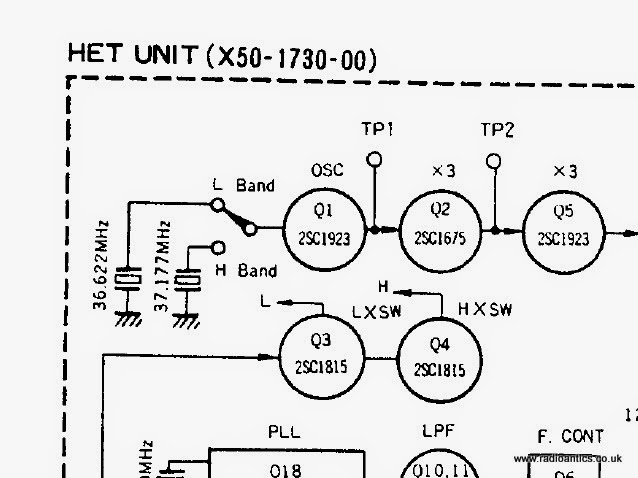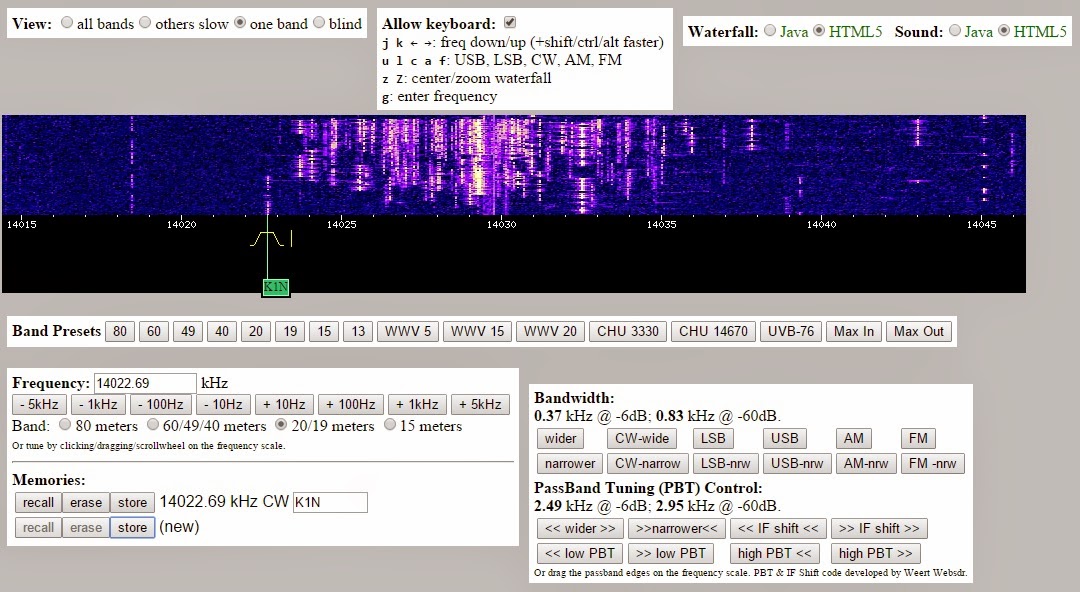 FYBO 2015 – this Saturday!
FYBO 2015 – this Saturday!
So I have several options. I can operate from outdoors - probably the picnic table in the back yard, but that's still covered with ice from last Monday's ice storm - it's never gotten above freezing since that nasty little clipper came through here. I can also operate from inside the Jeep. The advantage there is that all I have to do is plop the Buddistick on the roof - after I chip away the ice that's still on the top of it! But, with the heat off, the temperature inside the Jeep will be the same as the outdoors. Operating in this manner wouldn't qualify for the Mobile category, but it would be much dryer than the picnic table. I have time to decide - there's no hurry, and it will depend how adventurous I feel and how clogged up my head is on Saturday. Don't want this slight head cold that I am dealing with to develop into bronchitis or something worse.
FYBO rules haven't changed much, with the exception that this year, teams are being allowed. Here's the URL for the page with the latest rules posting: http://www.azscqrpions.com/fybo2009rules.html
I guess I should make sure all my batteries are charged up for this weekend!
72 de Larry W2LJ
QRP - When you care to send the very least!
Larry Makoski, W2LJ, is a regular contributor to AmateurRadio.com and writes from New Jersey, USA. Contact him at w2lj@arrl.net.
 More useful modules
More useful modules
Yet again, I am indebted to Steve G1KQH for the following:
Low cost AM modules yesterday, now the Dorji today.. Its just never ending what next comes along, I can’t keep up any longer going to have a funny turn!73 Steve
http://www.g1kqh.talktalk.net/
Roger Lapthorn, G3XBM, is a regular contributor to AmateurRadio.com and writes from Cambridge, England.
 Dimming my Ultrafire WF-501B
Dimming my Ultrafire WF-501B
I got this red LED flashlight as a Christmas present. But unfortunately the intensity was way too high for what I intended to use it for. A soft red light preserves your night vision, and is ideal for use with a telescope in the dark as was my intention. But if the intensity was as high as before the modification, night vision would suffer.
I then found this YouTube video describing how the controller circuit board could be replaced by one with more functions. As recommended I therefore ordered an AMC7135*8 2800mA 4-Group 5-Mode Circuit Board with 8 AMC7135 current regulators in parallel. The image shows the the original circuit board as connected before the modification in the front in the image and the new one behind it.
The new board gave me the choice of one of 4-groups:
- 3-mode: Lo (5%) – Hi (100%) – Strobe
- 3-mode: Lo (5%) – Mid (30%) – Hi (100%)
- 2-mode: Lo (10%) – Hi (100%)
- 5-mode: Lo (5%) – Mid (30%) – Hi (100%) – Strobe – SOS
Sverre Holm, LA3ZA, is a regular contributor to AmateurRadio.com and writes from Norway. Contact him at svholm54@gmail.com.
 CLE ‘Listeners’ Survey
CLE ‘Listeners’ Survey

The following message was sent to Yahoo Group's ndblist members early this morning, from Brian Keyte (G3SIA), CLE activity co-ordinator. Perhaps you are a member that doesn't get the mail or maybe a non-member that occasionally reads the group postings but missed the message. In any event, this short survey would help Brian to keep up with your ideas and activity when it comes to CLE planning. All that is needed is to 'copy and paste' the questionnaire into an email and send it to Brian's address, listed in the message.
Hello
About 70 of our NDB List members have taken part in recent CLEs - and the other 550 members haven't. Only about 250 members have ever sent a CLE log (including all ex-members), so more than 300 current members haven't.
If you are one of the 300+, do you sometimes look at our monthly CLE results and maybe find bits of them interesting or useful?
This is NOT a sales pitch to try and make you take part, welcome though that would be! However, if several 'non-CLE' Members are finding the results helpful, I would like to know whether we might improve the way the results are presented to make them more understandable and more useful to our members generally?
If you are interested, it would help me if you could please reply DIRECT TO ME at ndbcle@gmail.com
I will keep your reply confidential and I will try to acknowledge all replies individually - there may be just yours or there might be 100 of them !!
1. How often have you found any individual listener's CLE log of interest?
2. How often have you looked at any of the CLE combined results?
Sometimes
Often
3. (if any) Which results were of interest?
Tables, etc. in the CLE Archives
Things in the 'Co-ordinator's Comments' emails after the events.
4. Did you find that the results needed further explanation?
Yes, often
Yes, always
6. Have you sent your own listening log(s) to NDB List?
7. Finally, please confirm that you are one of the 300+
Brian Keyte
(CLE Co-ordinator)
Steve McDonald, VE7SL, is a regular contributor to AmateurRadio.com and writes from British Columbia, Canada. Contact him at ve7sl@shaw.ca.
 Final CQ magazine update
Final CQ magazine update
Mike Weir, VE9KK, is a regular contributor to AmateurRadio.com and writes from New Brunswick, Canada. Contact him at ve9kk@hotmail.com.
 Repairing a Kenwood TR9500, Part4
Repairing a Kenwood TR9500, Part4
After making repairs to the microphone amplifier and the receiver pre-amplifier the rig seemed to be working fine, I'd even used it several times during the UKAC contests with some success.
The 70cm band is under used locally and activity seems largely restricted to repeaters. Due to it's vintage the TR9500 doesn't have CTCSS tones and so cannot be used to access repeaters without some modification and I've been looking at adding a CTCSS board.
In the meantime I really wanted to use the TR9500 a bit more and was hoping to make it part of a satellite station, the TR9500 acting as the UHF uplink transmitter (LSB) and the VHF 2m TR9000 as the downlink receiver (USB) for the AO73 (FUNCube-1) and other satellites.
The satellite portion of the band plan is at 435-438MHz and it was when setting this up I discovered the TR9500 neither received or transmitted in the upper part of the 70cm band (435-440MHz) below this everything was hunky-dory.
It hasn't taken long to locate the issue, the HET unit employs two crystals L33 (36.6222MHz), L34 (37.1777MHz) which are switched in to the oscillator Q1 depending on the selected frequency. L33 being referred to as low band, L34 as high band the switching occurring around 435MHz.
The switching HL signal (via R10) and transistors Q3/Q4 are working correctly it is just crystal L34 is not resonating. The surrounding diodes, capacitors, inductors and resistors all look fine, no obvious shorts or broken joints.
I have to do some more diagnostics to rule out any of the passive components but if it is the case that the crystal has failed then it may prove difficult to source an economical replacement.
Andrew Garratt, MØNRD, is a regular contributor to AmateurRadio.com and writes from East Midlands, England. Contact him at nerdsville@gmail.com.
 K1N is Busy
K1N is Busy
With my KX3 on the fritz (boxed up, ships out tomorrow) I won’t be able to join in on the fun in chasing K1N on Navassa Island. But I did manage to sneak in some time this evening on K2SDR’s internet enabled software defined radio station. Just listening to the CW pileup makes you wonder if you’ll ever be good enough to pick them out of the pile! Here’s a view of what 20M CW is like….K1N is the station on the left…the rest to the right are in the pile!
Michael Brown, KG9DW, is a regular contributor to AmateurRadio.com and writes from Illinois, USA. Contact him at michael@thefarmonline.com.

















